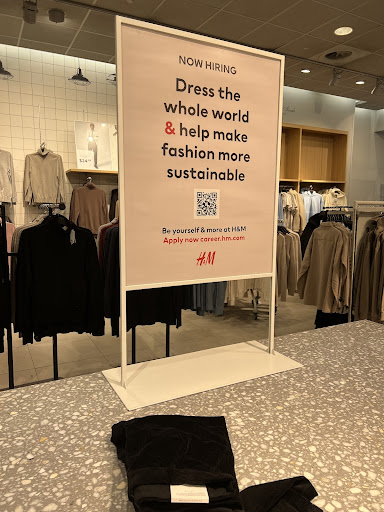The deadly axis of fast fashion

Photo courtesy of Saharla Mohamoud
According to Big Issue, H&M ‘Conscious’ collection, a separate clothing line within the store that boasts using recycled and eco-friendly materials, actually possesses 11% more damaging synthetics than the average item in H&M. This practice, called greenwashing, provides a false idea of the true environmental cost of an item to a consumer in order to make the brand look more appealing.
Sustainability is a word most fashion enthusiasts have become much more acquainted with in the last couple of years. While certain brands have created initiatives to be more transparent and ethical with the creation and sourcing of their materials, they have entirely ignored the devastation the fashion industry has caused to disadvantaged nations and blurred the lines of who is responsible for the very destruction.
Concerning how the Council of Textile Recycling reports that the average American throws away 70 tons of clothes every year, consumers need to be more comfortable with the idea of ‘outfit-repeating’ or sourcing second-hand clothes alternatives instead of popularizing the idea of having massive hauls from known fast fashion companies and buying into microtrends seen on the Instagram explore page. Yes, it’s unreasonable to assume everyone has $100 to spend on a good quality t-shirt, but it is also unreasonable to assume that it’s equally justifiable for someone who could easily afford that $100 t-shirt should go spend that money on a SHEIN haul. The less is more mentality needs to become a necessity in the fashion world as we enter an environmental crisis.
“Consuming less and keeping clothes for longer are everyday ways to help combat the issue,” said vice president of the Fashion Club, junior Raisa Nirjhar. “Personally, I like to thrift and support small businesses, because I find they have unique items that are much better quality and I also generally prefer vintage clothes.”
That same idea of less is more should be extended to the same corporations who push those notions on less-privileged consumers. As said before, not everyone can afford to spend money on the ‘sustainable’ brands. Especially when the average American makes approximately $50,000 annually and the average item on Reformation, one of the most popular sustainable brands, costs between $80-$330. Those sustainable companies can absolutely afford to cut back on manufacturing practices and environmental and physical abuse within less-privileged nations, as Nirjhar highlights.
“I think fast fashion is a complex issue,” said Nirjhar, “after all, it is one of the worst contributors to pollution and climate change. And many factory workers, especially in Bangladesh, [where I am from], endure brutal working conditions and unlivable wages.”
According to the Clean Clothes Campaign, garment factory workers across the Global South often work 10-12 hours a day, seven days a week, for well below living wages. Many workers are children, forced workers, and restricted from forming unions or refusing overtime if they don’t meet company expectations.
The conditions within these factories are also just as sickening, as shown through the infamous collapse of Rana Plaza in Bangladesh, where over a thousand workers were killed. The incident revealed that Rana Plaza was one of many factories where workers are forced to work with no ventilation, endure physical and verbal abuse, and go without breaks or water, all for Walmart, The Children’s Place, and Primark clothing.
Based on data from the UN Environmental Programme, the fashion world currently contributes 10% to greenhouse emissions and is projected to contribute 50% by 2030. According to Ecowatch, there are about 17 million tons of annual waste in landfills (only two tons of which are recycled) and two million tons of waste found in 70% of lakes and rivers across the developing world, particularly in Asia. Despite this large amount of waste, companies like Burberry report burning an estimated 37 million dollars worth of goods, and H&M reported they had four billion dollars worth of unsold clothes in inventory.
So what happens to these unbought clothes if the public decides to keep a minimalistic look? Without confrontation, the companies will make and burn their clothes anyway, the workers within those factories will still be put under the same disastrous conditions, the environment will continue to be polluted, and the fast fashion industry will, ironically, continue to be the most outdated industry.
“Capitalism definitely plays a role in fast fashion, because there is no way to completely consume ethically under it. However, people should still be mindful of how much they are buying and from where,”said Nirjhar. “Ultimately, production and manufacturing of the fashion industry must change. People should continue to call out fast fashion brands for real change.”
See the fight against fast fashion on a grand scale, one that needs to come with the consumer not buying into capitalist thought about what “fashion” is and mass corporations being held accountable for their unjust actions towards humanity. Don’t buy into their myths of corporate sustainability, and don’t buy into a purchasing game wrongfully referred to as fashion.





